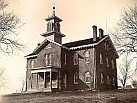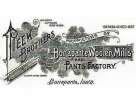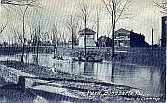CLAY M. LANMAN, PRESIDENT, 1967
Printed by The Record-Republican, Bonaparte, Iowa
their home trade, besides shipping large numbers to other portions of Iowa, also to Nebraska and Missouri. Parties wanting anything in their line should remember that they deal only in hand-made work. You could not buy a "cheap John" buggy or carriage of them at any price.
Stebbins Bros. Hardware Co. is one of Bonaparte's most enter-prising firms. The stock is quite large, comprising several lines, all complete—shelf and heavy hardware, lime, cement, plaster, hair, builders' material, barbed wire, pumps of all kinds, window glass, paints, oils, cast bobs, sleighs and cutters, and probably the most complete line of house furnishing goods in this section of Iowa, consisting of furniture of all grades and qualities, refrigerators silver-ware, queensware, glassware, stoves, oil cloth, window shades, etc. On visiting this firm we found the proprietors in good spirits, and well pleased with last year's trade.
This firm is doing an extensive business, and Mr. Stebbins had considerable to say about trade for the coming season, but space will not admit of its publication here. The firm has sold 144 stoves since Sept. 1, 1887, and has ordered ten thousand pounds of binding wire for the coming season.
The Jolly Melican Boss Tin Shop (Limited) Bicycle Base Ball Man is by far the leading light in his respective lines. He confines him-self exclusively to the manufacture of and dealing in stoves, tinware and house furnishing goods. He carries a fine stock, is a shrewd buyer, and his twenty-four years of experience has taught him that the best is the cheapest. He manufactures his own tin, sheet iron and copperware goods from the best material procurable. Guttering, spouting, decking, valleys, galvanized chimneys and job work, in all its branches, promptly and neatly executed.
The Bonaparte Pottery was started in 1866 by Parker and Han-back, and that firm conducted the business for five years, when Robert Wilson succeeded Mr. Parker. The firm name at present is Hanback and Wilson. They employ from six to ten hands and two teams. These works generally turn out about 125,000 gallons of pottery per year. They also make flower pots, drain pipe and fire proof bricks. There is quite a demand for their wares, and they are kept busy in filling orders. Thomas Hanback senior member of the firm, is traveling salesman.
The advertisers in this Holiday Visitor were the following:
T. I. Bradford, Bonaparte Livery, Feed and Sale Stable.
W. A. Packer, postmaster, full line of school supplies and stationery.
Will Page, barber.
C. H. Middleton, groceries, fruits and tobaccos.
E. B. Parker, Parker's Cafe.
Farmers & Traders State Bank, J. A. Johnson, cashier.
J. Q. Beck, Bonaparte Machine and Repair Shop.
J. B. Barnett, grain merchant.
D. E. Sedgwick, jeweler.
Una L. Chapman, Milliner.
Joseph Hinish, tailor.
L. C. Meek, breeder of horses and mules.
Hopkins and Van Dorn, dealers in boots and shoes.
Davis & Stutsman, drugs and patent medicines.
William Sivil, boots and shoes.
A. C. Huffman, groceries and queensware.
H. L. Coolidge, dry goods and groceries.
J. T. Humphryes, boots and shoes.
Noske Bros., harness and saddles.
Dr. B. P. Blackmar, physician and druggist.
L. H. Mills, groceries.
Christy & McDonald, dry goods and clothing.
L. Henry, photographer.
P. O. Beck, White Elephant Novelty Repair Works.
J. F. Perkins, breeder of horses and mules.
J. H. Cresap, live stock merchant.
W. W. Entler, general agency business.
W. E. Smith, Bonaparte Lumber Company.
George A. Demple, furniture and undertaking.
W. H. Brooker, Bonaparte Marble Works.
Samuel Sharp, the Park Hotel.
T. J. Feazel, photographer.
Mrs. Eason, the Eason House.
The township officers were: Trustee, A. Whitlock, Joseph Meek and T. W. Boyer. Clerk, Robert Wilson. Justices of the Peace, I. J. Hogan, W. W. Entler and J. P. Michler. Constable, Jacob Hogan.
School board: President, A. McDonald; Secretary, H. C. Creswell; treasurer, T. W. Boyer; directors, Robert Wilson, D. W. Riggle, W. E. Smith, William Meek and J. P. Davis.
The town was not then incorporated.
The Mormon pioneers marked the first great route from the Mississippi to the Missouri, opening up a thoroughfare which later guided thousands of home seekers to the great West. From the city of Nauvoo, largest city in Illinois, with a population of 20,000, refugees streamed across Iowa. In July of 1346, 15,000 people, with 3,000 wagons and 30,000 head of livestock were camped along the Iowa trails. Over 150 companies made the trek over a period of about 8 years.
In Van Buren County were several stopping points for the Mormon pioneers. The Journals express many different reactions to the scenes along the way. For some it meant merely a jolting ride, pleasant or painful, depending on the weather. For others it involved hard work, as some of the men split rails, built fence and homes for the local settlers, or worked on the farms in exchange for means to continue their journey.
Historians say they drove resistless bargains with the Iowa farmers, for their skill and labor, and that as a result, the spring of 1846 in the Des Moines valley above Farmington saw more frontier shanties replaced by two story dwellings than has occurred in any like time and area in any western state.
The first train consisted of 500 wagons, which approached Farmington Mar. 3, 1846, from a camp 4 miles below, near the present site of Croton. One party camped 3/4 mile No. of Farmington on property of a Dr. Jewett, while most of the company went on to the vicinity of Reed's Creek, 2 miles east of Bonaparte. On one of the steep hills along this stretch, one of the teams gave out and the wagon tipped over, injuring a woman. This is thought to have been near the old Slaughter farm area.
A group of men had gone ahead to work at "chopping and fencing" at Reed's Creek. The camp was 1/2 mile from the river bank, and it is of interest to note that two ladies, going for a walk in the evening, lost their way, and had to be escorted back to their wagon home. A burial ground for this camp remains on a bluff north of the Creek mouth, where local residents report graves marked very plainly. The WPA Writers Program attributes some of the burials in the Snyder Cem. in Bon. Twp., to the Mormon pioneers at this camp.
Grain of the pioneers was ground at the Bonaparte Mill. While some of the men remained behind to finish the work at Reed's Cr., the main body traveled 2 miles up river to Bonaparte where they
crossed the Des Moines. Brigham Young writes that they crossed just below Bonaparte Mills where the water was 2 feet deep. Eliza R. Snow writes that she slung a tin cup tied to a string into the river as they crossed, and found the water very refreshing.
Most journals agree that the hills on the south side of the river were difficult to negotiate . . . one writer describing them as almost perpendicular, and told of the difficulty of getting teams up hill after hill in the mud.
There were various camps going west from here . . . on Indian Cr., Fox River, with the last camp in the county being at Richardson's Point, near the Davis County border, about where the present road runs west from Lebanon. A Mormon burial ground lies deep in the woods on the Bonar farm near there.
There were countless smaller groups, branching out from the main companies, which camped, often for several months at a time at Reed's Creek, mouth of Bear Cr. near Vernon, Bentonsport, John Fitzgerald farm, Jacob Silver farm, Fatherson farm, Ely's Ford area at Keosauqua, and one group traveled up Coates (Honey) Cr. from Bonaparte, camping at the spot marked by the DAR on hiway No. 16.
The "Brass Band" which accompanied the first company, to "ease the discouragement of the travelers", played concerts for the Iowa citizens also . . . at Farmington on March 4th, and at Keosauqua on March 8, 10, 11, and 17, on the Main Street and on "Court House Hill".
The Historians of Iowa remind us that "in the persecution the Mormons endured in their early years, Iowa never joined. The people of Iowa seem to have enjoyed their music, made use of and paid fairly for, their labor and skills, and in general, conducted themselves in marked contrast with the officials and citizens of Missouri and Illinois, for which the struggling thousands of those pioneers years, must have been very grateful".
By Marion Flake, Bonaparte

The above picture showing Bonaparte from acros the river looking north was taken many, many years ago. This view shows the old woolen mill, grist mill and many other buildings of early Bonaparte.


Building of Bonaparte Bridge in 1877

The above picture must have been used on advertising literature by the woolen mills.

This picture was taken forty or so years ago and showed the old mill race during high water with a boat and canoe being used for a pleasure ride. In the background is the old band shell and the Rees Carriage Factory building.

Pictured above is the Eason Hotel building of early Bonaparte.

The above photo shows, according to old residents of Bonaparte, a blind horse that somehow got into the river above the dam and was swept downstream lodging on the dam. The horse was rescued according to our information and led from its perilous perch on the dam.